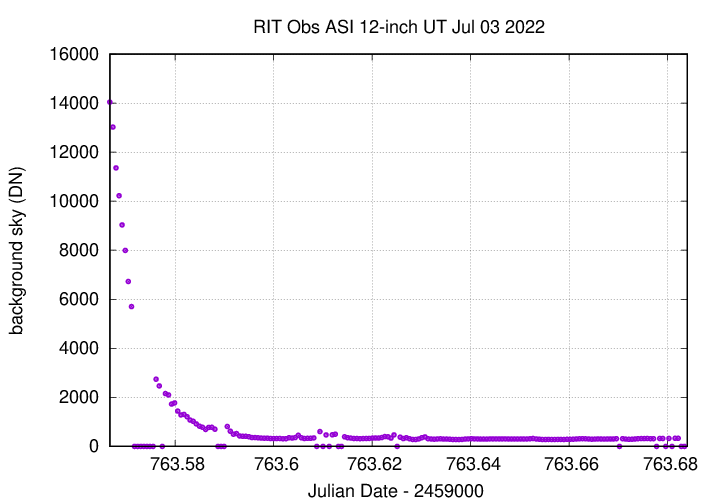
On the night of Jul 02/03, 2022, under poor conditions, I acquired images of the outbursting cataclysmic variable star U Sco.
Alas, clouds ruined almost the entire run. I was able to make decent measurements from just a half-hour or so near the start of the night. Rats.
U Sco is a cataclysmic variable which only rarely is caught in an outburst. This one was first noticed at UT 2022 June 6.720 by Masayuki Moriyama. The star reached a peak brightness of about V = 8, but faded quite a bit by this evening; it is currently about V = 14.8.
The main setup was:
Notes from the night:
The object is located at
RA = 16:22:30.78 Dec = -17:52:42.8 (J2000)
A chart of the field is shown below. The size of the chart is about 42 x 30 arcminutes.

I've marked the location of several comparison stars as well, which appear on the AAVSO chart of comparison stars.
I'll use star "A" to shift my instrumental magnitudes to the V-band scale.
I took a photo of the finder TV's screen when pointing to this target; this could be a useful reference for the future:

The sky value shows clouds early and late.

The FWHM graph below shows a pretty steady value.

Using aperture photometry with a radius of 7 pixels in clear filter (binned 4x4, each pixel is 1.052 arcsec, so a radius of 7.4 arcsec), I measured the instrumental magnitudes of a number of reference stars and the target. Following the procedures outlined by Kent Honeycutt's article on inhomogeneous ensemble photometry, I used all stars available in each image to define a reference frame, and measured each star against this frame.
Sigma-vs-mag plots show that the floor was about 0.015 mag for the small selection of images that I kept.

The change in zeropoint shows large gaps. I discarded all images except those in the first, early bunch shown on this graph.

The measurements are too brief to show any changes during the run.

You can download my measurements below. A copy of the header of the file is shown to explain the format.
# Measurements of U_Sco made at RIT Obs, UT 2022 Jul 3, # in poor conditions, # by Michael Richmond, # using Meade 12-inch LX200 and ASI 6200MM. # Exposures 45 seconds long, clear filter. # Tabulated times are midexposure (FITS header time - half exposure length) # and accurate only to +/- 1 second (??). # 'mag' is a differential magnitude based on ensemble photometry # using a circular aperture of radius 7 pix = 7.4 arcseconds. # which has been shifted so AAVSO 000-BBX-431 has mag=10.707 # which is its V-band magnitude according to AAVSO. # # UT_day JD HJD mag uncert Jul03.08553 2459763.58553 2459763.59039 14.814 0.038 Jul03.08616 2459763.58616 2459763.59102 14.765 0.037 Jul03.09308 2459763.59308 2459763.59794 14.800 0.038
Last modified 7/03/2022 by MWR.